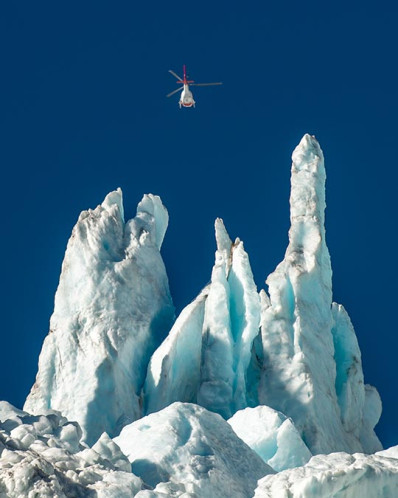The Franz Josef Glacier, located in the heart of New Zealand's West Coast, is a dynamic and mesmerising natural wonder. This glacier, like others around the world, is constantly moving and reshaping itself, creating a landscape that is both breathtaking and treacherous. Among its most intriguing features are crevasses, seracs, and ice falls. These elements not only contribute to the glacier's beauty but also pose significant challenges and hazards. Let's delve into these features and understand how they form and evolve.
Crevasses: The signature scars of the glacier
Crevasses are perhaps the most common and noticeable features on any glacier. These deep, gaping cracks are formed as the ice moves at different speeds down the valley. The dynamics of glacier movement are fascinating: the edges of the glacier move slower than the centre due to the immense friction caused by the valley walls. This differential movement creates tension within the ice, leading to the formation of crevasses.
Think of a glacier as a frozen river. Just as rapids form where a river flows over stationary rocks, crevasses form when a glacier moves over obstacles like large rocks or cliff faces. The glacier, unable to bend or flow smoothly over these obstacles, cracks under pressure, resulting in crevasses. The size of the rocks and the force exerted by the moving ice determine the width and depth of these crevasses. Therefore, in certain predictable areas where the glacier encounters significant obstacles, large crevasses often appear, much like consistent rapids in a river.
Seracs: Towering ice giants

When crevasses intersect, they create a striking pattern resembling a waffle or lattice shape. Over time, the remaining blocks of ice between intersecting crevasses stand isolated, forming towering structures known as seracs. These ice pillars can range in size from a few meters tall to the height of multi-story buildings. Seracs are notoriously unstable, especially under the heat of the sun, which can cause them to collapse without warning.
Seracs contribute significantly to the glacier's dramatic landscape. They stand as silent sentinels, a testament to the glacier's relentless movement and the power of nature. However, their instability poses serious risks, making certain areas of the glacier particularly hazardous for climbers and explorers.
Ice Falls: Frozen waterfalls
One of the most spectacular sights on the Franz Josef Glacier is the ice falls. These occur when the glacier flows over steep cliff faces, resulting in a chaotic jumble of crevasses and seracs. The ice tumbles over these cliffs, creating a frozen cascade that mirrors the appearance of a waterfall. Ice falls are characterized by their steep, rugged terrain and constant movement, as the ice continually fractures and shifts.
Our current guide site on the Franz Josef Glacier is situated between two major cliff bands, providing an unparalleled view of these magnificent ice falls. This unique location offers a dramatic and ever-changing landscape that highlights the glacier's dynamic nature. Every day on the glacier presents a new scene, as the ice moves and reshapes itself, creating new crevasses, seracs, and ice falls.
An ever-changing landscape
The Franz Josef Glacier is a living entity, continuously evolving and sculpting its surroundings. For manuhiri (visitors) and guides alike, this means no two days on the glacier are ever the same and each experience offers new terrain and spectacular landscapes.
As we explore this frozen wonderland, it's crucial to appreciate both its beauty and its inherent risks. The glacier demands respect and caution, but for those willing to venture into its icy realm guided by our experts, it offers a journey unlike any other. Whether you're an experienced climber or a curious traveller, the Franz Josef Glacier promises an unforgettable adventure.
Read about the experiences we offer that can show you these spectacular formations.
